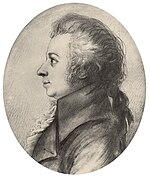music.wikisort.org - Composition
Wolfgang Amadeus Mozart's Piano Sonata No. 15 in F major, KV 533/494 (finished 3 January 1788) is a sonata in three movements:
- Allegro
- Andante in B♭ major
- Rondo: Allegretto
| Piano Sonata in F major | |
|---|---|
| No. 15 | |
| by W. A. Mozart | |
 Drawing of Mozart in silverpoint by Dora Stock in 1789 | |
| Key | F major |
| Catalogue | K. 533 |
| Style | Classical period |
| Composed | 1788 |
| Movements | Three (Allegro, Andante, Rondo: Allegretto) |
A typical performance takes about 23 minutes.
The Rondo was originally a stand-alone piece composed by Mozart in 1786 (Rondo No. 2, K. 494 in the Köchel catalogue). In 1788, Mozart wrote the first two movements of K. 533 and incorporated a revised version of K. 494 as the finale, having lengthened it in order to provide a more substantial counterpart to the other two movements.[1]

Other arrangements
Edvard Grieg arranged this sonata for 2 pianos, by adding further accompaniment on the secondo part, whilst the primo part plays the original.[2] This attempt to "impart to several of Mozart's sonatas a tonal effect appealing to our modern ears" serves to document the taste of Grieg's late nineteenth-century Norwegian audience.[3] A notable recording is that of Elisabeth Leonskaja accompanied by Sviatoslav Richter.
Notes
- All Music Guide
- "Piano Sonata No.15 in F major, K.533/494 (Mozart, Wolfgang Amadeus) - IMSLP/Petrucci Music Library: Free Public Domain Sheet Music". imslp.org. Retrieved 2018-07-17.
- hfinch (2013-01-09). "Mozart, arr Grieg Piano Sonatas". www.gramophone.co.uk. Retrieved 2018-07-17.
External links
- Sonate in F KV 533/KV 494: Score and critical report (in German) in the Neue Mozart-Ausgabe
- Piano Sonata No. 15: Scores at the International Music Score Library Project
- Performance of Piano Sonata No. 15 by Jonathan Biss from the Isabella Stewart Gardner Museum in MP3 format
Другой контент может иметь иную лицензию. Перед использованием материалов сайта WikiSort.org внимательно изучите правила лицензирования конкретных элементов наполнения сайта.
WikiSort.org - проект по пересортировке и дополнению контента Википедии